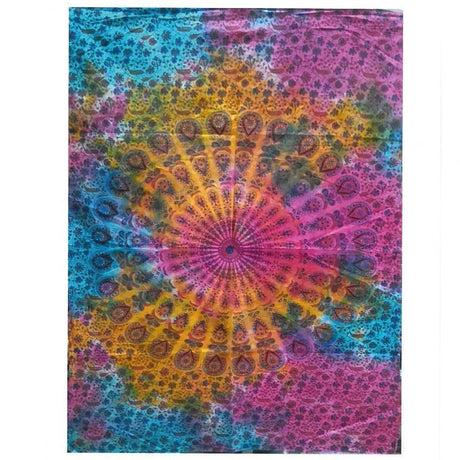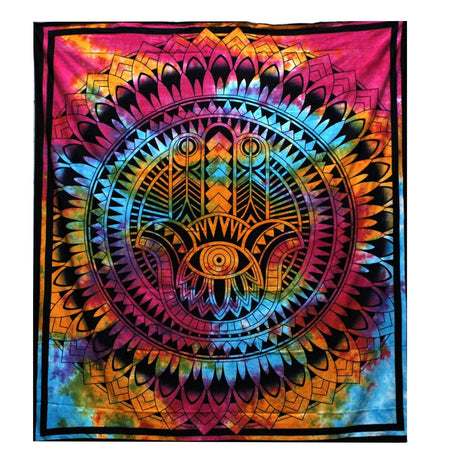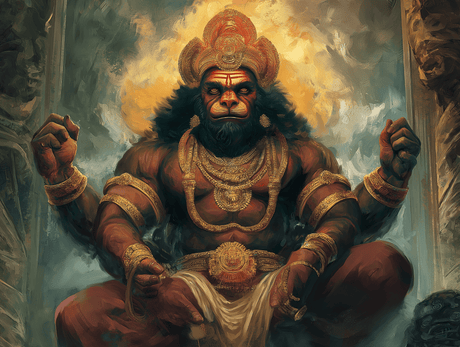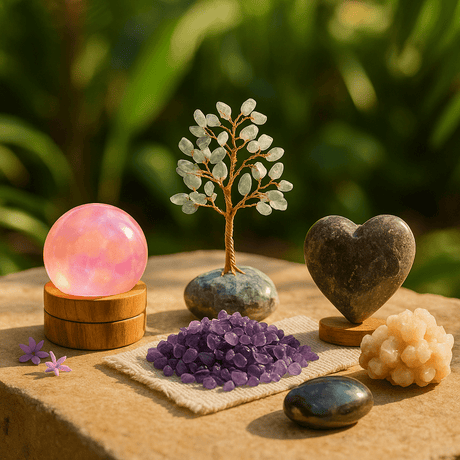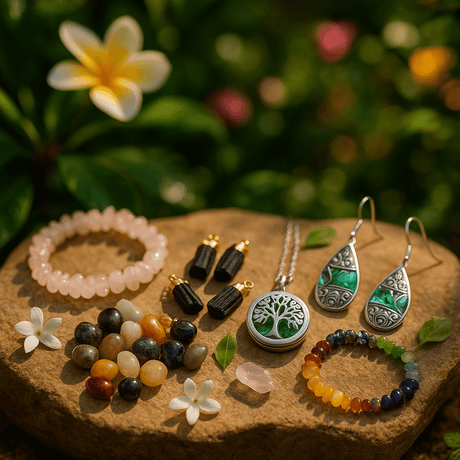Mandalas are complex designs that have been used for a long time in things like religious rituals and meditation. These days, they’re popping up everywhere – as stylish home decor, on clothing, and as tattoos.
Let’s look at what mandalas mean, how people use them in different ways, and how you can add a touch of their special meaning to your life, all through the eyes of those who know them best.
What is a Mandala?
A mandala, meaning “circle” in Sanskrit, is far more than a simple shape. It's a symbol that represents the complexity of the universe and our innermost selves. Originating from ancient Hindu scriptures like the Rig Veda around 1500 to 500 BCE, mandalas are considered to be geometric blueprints of higher consciousness and are used across spiritual practices to focus attention and set intentions. With their symmetrical patterns radiating from the center, mandalas are visual metaphors for the journey from life's external facets to the sacred core of our being. Employed in traditions of Hinduism, Buddhism, and beyond, they function as cosmic diagrams that guide devotees through layers of existence, from the tangible world to an enlightened state, often symbolizing the transformation from suffering to joy.
Where Did Mandalas Originate and What Cultures Embrace Them?
Mandalas trace their origins to ancient times, primarily emerging from the spiritual traditions of India. The term itself, rooted in the language of Sanskrit, captures the concept of a universe organized around a unifying center. This profound symbol first graced the pages of the Rig Veda, one of the oldest Hindu texts, suggesting a history that spans back to at least 1500 BCE.
As mandalas evolved, they became integral to the practices of multiple cultures across Asia, particularly within Buddhist communities that date back to the fourth century BCE. These intricate designs are not just limited to Hinduism and Buddhism; they also hold significance in Jainism and Shintoism, symbolizing everything from sacred spaces to maps of the divine.
In their most universal application, mandalas are synonymous with balance and harmony, embodying spiritual journeys that cross cultural boundaries. They are artistic and spiritual compasses, guiding seekers from the outer periphery of existence to the profound depths of enlightenment. Whether etched into the architecture of temples or gently assembled in Tibetan sand paintings, mandalas represent a convergence of artistry and spirituality found in diverse regions such as Bhutan, China, India, Indonesia, Japan, Nepal, and Tibet.
What is the Symbolism Behind the Designs In Mandalas?
The designs in mandalas carry deep symbolic significance, mirroring spiritual concepts and the cosmos.
- Center Point. At the heart of every mandala, the center point stands for unity and the essence of the universe, serving as a starting place for reflection and spiritual journeying.
- Geometric Shapes and Patterns. Surrounding the center, various shapes and patterns unfold, each layer rich with meaning and designed to guide the observer from the external world to inner enlightenment.
- Squares and Circles. These shapes symbolize the stability of the earth and the cyclical nature of life, grounding the mandala in physical and temporal realities.
- Quadrants. Often, mandalas are divided into quadrants that represent the cardinal directions and the four elements, acting as a cosmological map for spiritual navigation.
- Colors. The choice of colors in a mandala is deeply symbolic, with white symbolizing purity, red indicating strength, and blue denoting wisdom, among others, each adding layers of meaning to the design.
- Overall Structure. The collective arrangement of a mandala’s elements, from its core to its outermost layer, functions as a meditative tool, inviting deep contemplation on life’s interconnectedness and the harmony of the cosmos.
- Spiritual Pilgrimage. The act of engaging with a mandala, whether through creation or contemplation, is akin to embarking on a spiritual journey towards enlightenment, providing insights into the universe and one’s place within it.

How are Mandalas Used in Spiritual or Religious Practices?
In spiritual and religious practices, mandalas serve as powerful tools for meditation, focus, and introspection. Traditionally rooted in Hinduism and Buddhism, they are employed to aid practitioners in entering a state of deep meditation, acting as visual aids that symbolize the universe and the spiritual journey from the outer world to the inner essence.
In Buddhism, mandalas are often created with colored sand in intricate ceremonies, only to be dismantled upon completion, symbolizing the impermanence of life. This ritual underscores the Buddhist teachings of detachment and the transient nature of the physical world.
Hinduism utilizes mandalas in yantras, geometric diagrams that embody the abode of deities. These are used in pujas (worship) and sadhana (spiritual practices) to invoke divine energies and foster a connection with the divine.
Jainism and Shintoism also incorporate mandalas as representations of the cosmos or maps for spiritual guidance, demonstrating their widespread use across different cultures as tools for enlightenment and spiritual insight.
Mandalas thus transcend simple artistry, embodying sacred symbols that guide individuals through their spiritual practices, whether it be through meditation, prayer, or contemplation, facilitating a deeper understanding and connection with the divine.
Types of Mandalas
There are different types of mandalas, each distinguished by its use, symbolism, and origin across various cultures and spiritual traditions. The diversity in mandalas reflects their adaptability and significance in serving as tools for meditation, reflection, and expression of sacred concepts.
- Buddhist Mandalas. Often used in meditation and rituals, these mandalas are complex and meticulously designed, symbolizing the universe and enlightened mind. Sand mandalas, created and then destroyed in a ritual, underscore the impermanence of life.
- Hindu Mandalas. Known as Yantras, these are geometric designs representing the cosmos and serve as an aid in meditation and spiritual growth. Each Yantra is associated with specific deities and aspects of life.
- Healing Mandalas. Focused on delivering peace and healing, these mandalas are used in therapy and personal growth, aiding in stress relief and self-discovery. They often feature soothing patterns and colors.
- Teaching Mandalas. Used primarily for instruction, these mandalas illustrate moral values and spiritual teachings, making complex philosophical concepts more accessible through visual representation.
- Sand Mandalas. Apart from their Buddhist significance, sand mandalas are a universal tool for healing and purification, drawing upon the natural energy of the earth.
Each type of mandala, whether it be a Buddhist Thangka, a Hindu Yantra, or a healing mandala, serves a unique purpose in guiding the practitioner or observer towards a deeper understanding of the universe and oneself. The distinctions lie not only in their visual characteristics but also in the intentions behind their creation and use, making mandalas a versatile and profound element of spiritual practice.

Materials and Techniques Used to Create Mandalas
Creating mandalas involves a diverse array of materials and techniques, reflecting the rich traditions from which they originate and the personal creativity of the artist. Historically and in contemporary practices, the following materials and methods are commonly employed:
- Colored Sand. In Tibetan Buddhism, sand mandalas are meticulously crafted from finely ground colored stones. Monks use small tubes, funnels, and scrapers to lay the sand in precise patterns and symbols, a practice that requires patience and symbolizes the impermanence of life.
- Paint and Canvas. Artists often use traditional paint on canvas or paper to create mandalas, employing brushes to detail the intricate patterns and vibrant colors that characterize these symbols.
- Digital Tools. With the advent of digital art, software and apps allow for the creation of mandalas using graphic design tools. This method offers a modern twist on mandala art, enabling artists to experiment with limitless colors and patterns.
- Natural Elements. Some mandalas are formed using natural materials such as leaves, stones, and flowers. These mandalas often emphasize a connection with nature and the transient beauty of the material world.
- Textiles. Mandalas are also woven into textiles, such as tapestries and carpets, utilizing various stitching and embroidery techniques to bring the designs to life.
- Wood Carving. Woodworkers may carve mandala patterns into furniture, decor items, or standalone pieces, showcasing the detailed craftsmanship and adding a tactile dimension to the art form.

Mandalas as a Form of Meditation and Therapy
Creating or coloring mandalas can be considered a form of meditation and therapy. This practice harnesses the meditative power of focusing intently on repetitive patterns and colors, leading to a heightened state of mindfulness and relaxation. Here's how mandalas serve as therapeutic and meditative tools:
Therapeutic Benefits
- Stress Reduction. Engaging in mandala activities shifts focus from stress, easing anxiety and promoting calm.
- Emotional Expression. Mandalas provide a way to express emotions non-verbally, offering an emotional outlet.
- Increased Focus and Concentration. Focusing on mandala patterns enhances concentration and attention.
- Creativity and Self-Expression. Creating mandalas boosts imagination and allows for personal expression.
Meditative Benefits
- Mindfulness Practice. Coloring or drawing mandalas promotes mindfulness, leading to a state of meditation.
- Centering and Balancing. Mandalas encourage a journey inward, fostering self-reflection and balance.
- Visualization and Manifestation. Mandalas are tools for visualization, aiding in manifesting desired states and higher consciousness.
In both therapeutic and meditative contexts, mandalas serve as effective tools for personal growth, healing, and self-discovery. Their symmetrical, repetitive patterns facilitate a tranquil mental state, making mandala art a valuable practice for individuals seeking to enhance their mental well-being and spiritual awareness.

Mandalas' Influence on Modern Art and Culture
Mandalas have deeply impacted modern art and culture, evolving from sacred symbols to icons of creativity and personal growth. Here's a brief look at their diverse influences:
- Psychotherapy and Jungian Analysis. Carl Jung's integration of mandalas into psychotherapy highlighted their role in exploring the subconscious, influencing therapeutic art practices.
- Art and Design. Mandalas inspire creativity across various art forms, enhancing graphic design, architecture, and fashion with their patterns and symbolism.
- Wellness and Mindfulness Movements. Mandalas are key in meditation and stress relief within wellness practices, highlighted by their presence in coloring books for their soothing effects.
- Education. Used as educational tools, mandalas help teach geometry, symmetry, and art, while promoting focus and calmness in learning environments.
- Popular Culture. Featured in movies, music videos, and festivals, mandalas symbolize unity and mystical journeys, captivating audiences globally.
- Digital Media. The advent of digital art has allowed for innovative mandala designs, with social media amplifying their reach and popularity.
- Spiritual and Secular Practices. Mandala practices extend beyond religious traditions, embraced by many for spiritual exploration or artistic expression, underscoring their universal appeal.
Mandalas' broad impact illustrates their significance in fostering a collective yearning for meaning and balance in modern life.

Can Anyone Create a Mandala, or Does It Require Specific Knowledge or Skills?
Anyone can create a mandala, and it doesn't require specific knowledge or artistic skills. Mandalas are accessible to all as a form of expression and meditation. The process can be as simple or intricate as one chooses, making it a versatile practice for both beginners and experienced artists. The creation of a mandala focuses more on the act of drawing as a mindful or therapeutic exercise, rather than on the outcome. This inclusive aspect encourages individuals to explore their creativity and find a sense of calm and focus, regardless of their artistic background.
Embrace the Mandala Way 🌀
Mandalas, ancient symbols rooted in Hindu scriptures, represent the universe and our inner selves, guiding individuals through meditation and spiritual insight across various cultures. They symbolize balance, enlightenment, and the journey from the external world to the inner core.
Discover the serenity and power of Mandalas with SHAMTAM's diverse collection, featuring tapestries, keychains, pendants, and more, each designed to bring peace and purpose into your daily life.
















